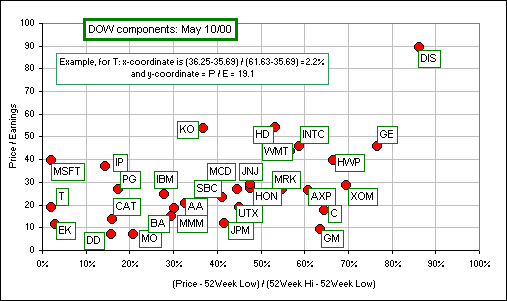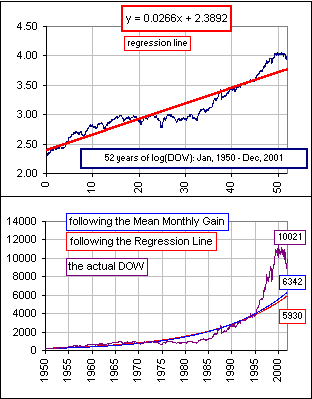|
Over a hundred years ago (1986), Charles H. Dow picked a dozen (12) stocks, each representing some component of the U.S. economy (Distilling & Cattle Feeding Co. and American Cotton Oil and, would-you-believe, General Electric etc.), and averaged their stock prices, like so:
In 1928, the number of stocks increased to 30 (and that's where it stands now) and each of these thirty stocks still represents some component of the U.S. economy: General Motors (for autos, etc.) and Merck (for pharmaceuticals) and Walmart (for retailers/department stores) and Coca Cola (for food and beverage) and ... you get the idea.
Anyway, here they are:
 Of course, when a stock splits 2-for-1, or when one stock is replaced by another (with a different stock price), we don't want the DOW average to change discontinuously ... so we adjust that divisor of 30. (Well, we, don't ... the editors of the Wall Street Journal do. Did I mention that Charles H. Dow is no longer with us?). The divisor now stands at ... uh, can't remember ... something like 0.14 but y'all may be able to find the current value at the Dow Jones web site. P.S. For a divisor of 0.14, each $1 change in a stock price means a change in the Dow Jones Industrial Average of $1/0.14, about 7 points. See also about Market Indexes
Here's an interesting chart:

Now, if we were Bottom Fishers or Value Investors, looking for a blue chip stock which has a low Price/Earnings ratio and is near its 52-week low (I guess that's bottom fishing), we'd gaze at the chart ... and covet those stocks nearest the origin, eh? Like mebbe:
EK = Eastman Kodak
What a difference a year makes!
 'course, American Express had a 3:1 stock split about a year ago so its price, and weight, got cut to 1/3! And the weights according to Market Capitalization?


And how 'bout Volatility?
See also gummy BEARS and TSE & DOW & NASDAQ and DOW: weekdays

Note:
Further, that divisor (that replaced the original "30") now stands at about 0.126 so a $1 change in any stock price will change the DOW by 1/0.126 ... about 8 points. |



